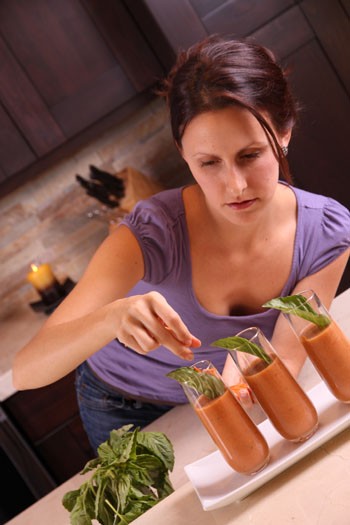
Hardest lesson you've learned:
You're not going to please everyone. As much as we try to create the perfect experience, each customer has his or her own set of expectations. Perfection is a great idea, but not always possible. Learning this lesson has been a consistent reminder for me to always do my best and be happy with that.
What should the last meal on Earth be?
Honestly, I believe food is fuel for the soul, so it should be your favorite food. For me, it would be a big bowl of guacamole, tahini cheese and our tostada shells.
]
Who's your hero, culinary or otherwise?
Well, this is a hard one; I have so many great teachers whom I admire. Someone who I've learned a lot from lately is my friend Jessica. She has really helped me understand the nature of day-to-day experience and has helped me learn to allow any negativity to roll off my shoulders while staying focused on what really matters.
Why did you open a vegan/raw restaurant so close to Native Foods? It also specializes in meat-free dining.
Its take on meat-free dining is COMPLETELY different from ours. Without going too crazy into the details, our offering has a huge emphasis on purity–pure foods without preservatives, without fried fats, without processing and unhealthy ingredients, natural vegetarian foods–not meat substitutes or animal-product imitations. If you look at our menu, everything has a unique name unrelated to animal products–when you make the choice to set away from those ingredients, you don't want a constant reminder of them every time you eat; this should be a new experience to explore. Plant-based cuisine is a unique category of food preparation. Also, we take it one step further than Native Foods: no stoves or ovens, only dehydrators and the freshest ingredients possible, staying with the premise that preparing foods at 118 degrees or lower maintains the vital enzymes and nutrient value. A diet rich in living cuisine leads to a healthy, disease-free body–vegan food can still be junk food when it's fried. On the flipside, being a part of the community at the Camp has been great for our business; many like-minded people congregate here, and now, they have options that run the spectrum of cuisines.
Is there a big vegan/raw community in Orange County to support you, or are diners mostly new to the cuisine?
We get a mix of 50/50. Our idea here was not to market to the category of folks who have already discovered this lifestyle as much as it was to show folks alternatives for cuisine that could benefit their health which they would have otherwise never experienced.
Where do you get your ingredients from?
Many are sourced from local farms, and the rest come from around the world. For example, we get many of our greens from two local OC farms, but our organic raw cacao comes from a small farm in Venezuela.
What is the biggest misconception you think Americans have about vegan food? For too many of us, we think it does not satiate our appetites.
Two things: First, people think that living cuisine is carrot sticks and celery; they have no idea of the culinary possibilities for healthy foods. Second, people think that eating healthy food has to be boring, that it lacks in flavor, substance and culinary options. It's the opposite, truly, but you have to be open-minded about it. Non-foods that are included in all processed foods like bread and commercial sauces are addictive. It takes 21 days to get that “junk” out of your body so you can taste properly–crazy!
How do you explain the difference between a vegetarian and a vegan?
Vegans don't eat any type of animal products, including honey and dairy. Vegetarians eat dairy and other animal byproducts.
What dish would you tell newcomers to try first?
First, I would find out the flavors and textures people enjoy in “traditional” foods, then I would direct them to something similar in this type of cuisine. For example, if they love Spanish food, they must try our mole enchiladas or our “Baja” tostada. If they love Italian cuisine, they simply must try our lasagna and pesto-stuffed mushrooms!
What would you be doing if you weren't in this business?
HA! Great question. . . . Probably painting–I LOVE art–and life coaching. I am very passionate about helping folks find a healthy lifestyle they love.
What advice do you have for those who might be thinking about a career in food?
Learn everything you can about all aspects of a restaurant. You will be successful in the kitchen if you really understand what people are looking for when they come into a restaurant.
What do you see yourself doing in five years? Ten years?
Creating recipes for a chain of 118 locations, writing more books (such as Raw Basics, due July 2011 through Hay House), and speaking on how to get
healthy and live the life of your dreams.
A contributing writer for OC Weekly, Anne Marie freelances for multiple online and print publications, and guest judges for culinary competitions. A Bay Area transplant, she graduated with a degree in Hospitality Management from Cal Poly Pomona. Find her on Instagram as brekkiefan.

